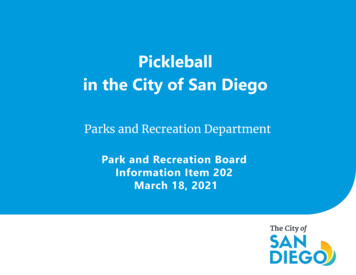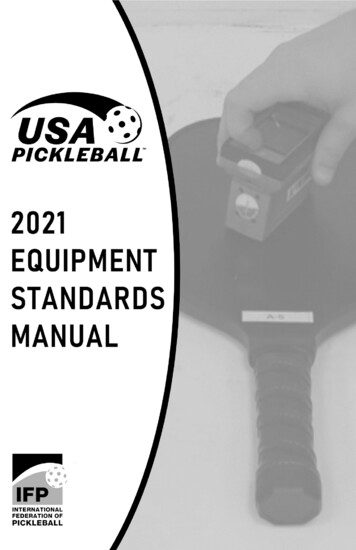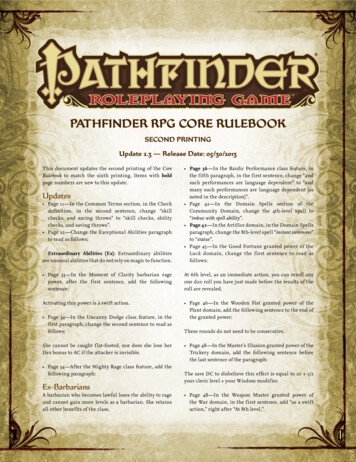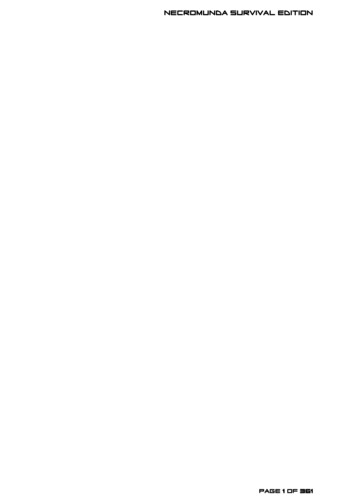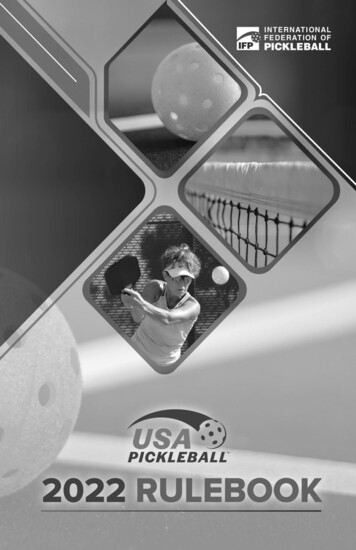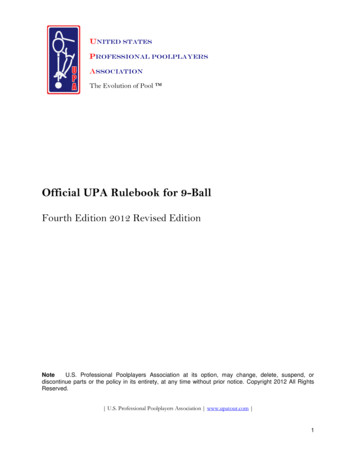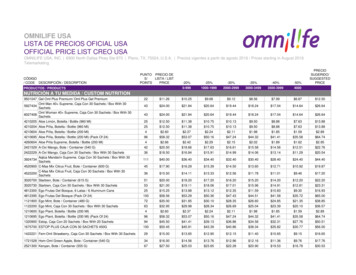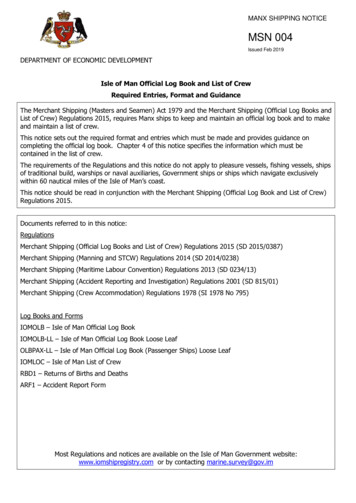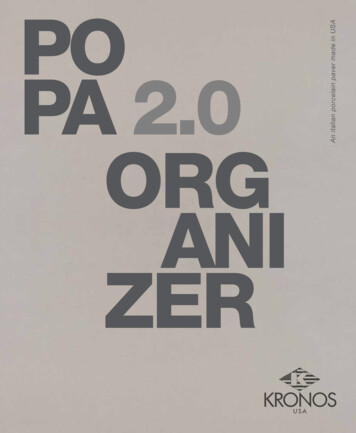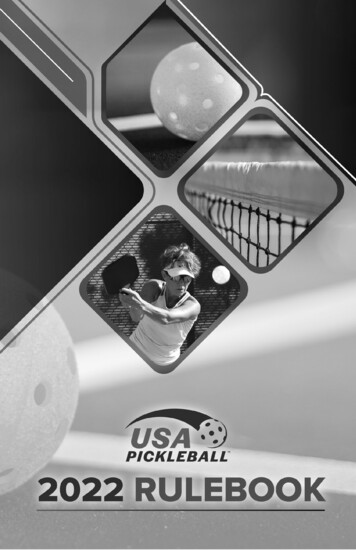
Transcription
USA PICKLEBALL OFFICIAL RULEBOOKThe USA Pickleball Association (USA PICKLEBALL) was organized toperpetuate the growth and advancement of pickleball on anational level and to set goals for worldwide play and recognition.USA PICKLEBALL is committed to furthering the growth anddevelopment of pickleball among all players.USA PICKLEBALL is the governing body of American Pickleball thatformulates and interprets all the rules of the sport in a mannerthat preserves the traditional nature and character of the sportand the skills traditionally required to play the sport. All suchdecisions by USA PICKLEBALL are final and not appealable.The purpose of the rulebook is to provide pickleball players withthe rules necessary for recreational, social, organized league andtournament play. Some sections of this rulebook are designed tobe used only for the conduct of sanctioned tournaments. Asanctioned tournament allows players to obtain a rating on anational or international basis.Non-sanctioned tournaments may also use these sections asguidelines. Tournament Directors for non-sanctioned tournamentsmay be flexible in the use of these guidelines to better fit the skills,ages, and diversity of their players. USA PICKLEBALLenthusiastically encourages these non-sanctioned tournaments topromote knowledge and growth of the sport, and skilldevelopment, while having fun playing pickleball.USA PICKLEBALL published the first rulebook in March 1984.USA PICKLEBALL Official Rulebook (2022)I
These rules will not be changed without good cause. Commentsand opinions are always welcome. If you have any questions inregard to the rules, please visit:USA Pickleball Association (USA PICKLEBALL)Website: usapickleball.orgCover Photo and Design Credit: Steve Taylor, Digital Spatula 2010, revised 2022IIUSA PICKLEBALL Official Rulebook (2022)
SIGNIFICANT RULE CHANGES FOR 2022Spin Serves (4.A.5)In 2022, the server shall use only one hand to release the ball toperform the serve. If the ball is visibly spun by the server duringthe release, the part(s) of the hand contacting the ball must bebare.The Drop Serve (4.A.6)No changes were made to the drop serve other than to remove itsProvisional status.Wrong Score Called (4.K)The rules concerning what happens if the wrong score is called bya player or a referee have changed. If a player thinks a wrongscore has been called, a player may stop play to ask for acorrection before the ball is served. If it has been served, the rallyis to be played out and the score correction (if any) is made beforethe next serve occurs.A Dropped Ball (7.N)In non-officiated matches, it is not uncommon for a player to carryan extra ball. If an extra ball is carried, it must not be visible to theopponent. If a player accidentally drops an extra ball during a rally,it will result in a fault. This does not apply in an officiated matchbecause the referee is responsible for removing any extrapickleballs from play.Medical Time-outs Called by a Referee (10.H.2.a)If a referee, in the interest of player safety, determines that eithermedical personnel or the Tournament Director should beconsulted for a player health issue, that time-out is not chargeableto the player as a medical time-out. The player retains the right tocall their own medical time out later in the match, if needed.USA PICKLEBALL Official Rulebook (2022)III
Verbal Warnings (13.G.1)A referee may now issue verbal warnings for more than justprofanity. Any situation that could result in a Technical Warningmay instead be addressed by the referee as a verbal warning.Only one verbal warning per match, no matter what the infraction,may be issued to a team, or player in singles.Calling the Score After a 15 Second Warning (10.A.5)Instead of a referee calling the score immediately after the 15second warning expires, the referee will call the score after theplayers are ready, or should be ready.When to Assess a Technical Warning or Foul (13.G.3.e)Referees are empowered to issue Technical Warnings or TechnicalFouls for various reasons but it has been unclear exactly when atechnical should be announced. The 2022 rules now make it clearthat a referee will not stop a rally to call a technical warning or foulon an offending team. Any technical warnings or fouls will beassessed after the rally is over.Earbuds (11.P)While some sports allow coaching during active play, pickleballdoes not. Since it is possible that a player could receive coachingvia earbuds, earbuds will not be permitted on the court duringtournaments with the exception of hearing aids.Tournament Score for a Retirement (12.F.6.a)The score recorded for a player or team that elects to “retire' froma match has been revised to allow the actual score of the matchfor that team to be recorded. A team retiring may play additionalmatches in their bracket if any are warranted.IVUSA PICKLEBALL Official Rulebook (2022)
TABLE OF CONTENTSSECTION 1 – THE GAME . 1SECTION 2 – COURT AND EQUIPMENT . 3SECTION 3 – DEFINITIONS . 11SECTION 4 – THE SERVE, SERVICE SEQUENCE, AND SCORING RULES . 17SECTION 5 – SERVICE AND END SELECTION RULES . 27SECTION 6 – LINE CALL RULES . 29SECTION 7 – FAULT RULES . 32SECTION 8 – DEAD BALL RULES. 34SECTION 9 – NON-VOLLEY-ZONE RULES . 35SECTION 10 – TIME-OUT RULES . 37SECTION 11 – OTHER RULES . 42SECTION 12 – SANCTIONED TOURNAMENT POLICIES . 46SECTION 13 – TOURNAMENT MANAGEMENT AND OFFICIATING . 53APPENDIX A . 66INDEX . 69NOTES . 73USA PICKLEBALL Official Rulebook (2022)V
SECTION 1 – THE GAMEPickleball is a paddle sport played using a special perforated ballon a 20-foot-by-44-foot court with a tennis-type net. The court isdivided into right/even and left/odd service courts and non-volleyzones. (See Figure 2-1.)The ball is served diagonally across the net to the opponent’sreceiving court using an approved motion. The ball is struck backand forth across the net until a player fails to return the ball inaccordance with the rules.Points are scored only by the serving side when the server or theserver’s team wins the rally, or the opposing side commits a fault.The server continues to serve, alternating service courts, until theserving side loses the rally or commits a fault.Typically, the first side scoring 11 points and leading by at least a2-point margin wins.Pickleball can be played as singles or doubles.The PlayersPickleball is a game that requires cooperation and courtesy. Asense of fair play from giving the opponent the benefit of anydoubt is essential in maintaining the game’s underlying principlesof fun and competition. To that end: All points played are treated the same regardless of theirimportance; the first point of the match is as important asmatch point.Either partner in doubles can make calls, especially linecalls; there is no place in the game for one partner tellinganother, “that was my call, not yours”.USA PICKLEBALL Official Rulebook (2022)1
Prompt calls eliminate the ‘two chance option’. Forexample, a player cannot claim a hinder from a ball rollingon the court after they hit a ball ‘out’; they gave up theirability to call the hinder by choosing instead to hit the ball.Players strive to cooperate when confronted with asituation not covered by the Rulebook. Possible outcomescan be a replay, allowing the rally to stand, or in extremecases, asking for a referee to resolve a dispute.Where possible, rules accommodate players with variousadaptive needsUnique FeaturesTwo-Bounce Rule. After the ball is served, each side must makeone groundstroke prior to volleying the ball.Non-Volley Zone (NVZ). An area that extends 7 feet from the neton each side, within which a player is not allowed to strike the ballwithout it first bouncing. More specifically, the whole court fromnet to baseline is the same and can be freely used for all play withone exception: volleying. The first seven feet, the non-volley zone,cannot be used for volleying.(Wheelchair) Players using wheelchairs may allow the ball tobounce twice before returning the ball. The second bounce canbe anywhere on the playing surface.2USA PICKLEBALL Official Rulebook (2022)
SECTION 2 – COURT AND EQUIPMENT2.A. Court Specifications. The dimensions and measurements forthe standard pickleball court are:Figure 2-12.A.1. The court shall be a rectangle measuring 20 feet (6.10m) wide and 44 feet (13.41 m) long for both singlesand doubles matches. (See Figure 2-1.)2.A.2. Court measurements shall be made to the outside ofthe perimeter and non-volley zone lines. All linesshould be 2 inches (5.08 cm) wide and the samecolor, clearly contrasting with the color of the playingsurface.2.A.3. The minimum playing surface area measures 30 feet(9.14 m) wide and 60 feet (18.29 m) long. A 10-foot(3.05-m) surrounding margin measures 40 feet (12.19USA PICKLEBALL Official Rulebook (2022)3
m) by 64 feet (19.51 m). Other recommendations forplaying surface dimensions are:PurposeNew ConstructionTournament PlayWheelchair PlayStadium CourtWidth – feet (m)34 (10.36 m)34 (10.36 m)44 (13.41 m)50 (15.24 m)Length – feet (m)64 (19.5 m)64 (19.5 m)74 (22.56 m)80 (24.38 m)2.A.4. (Wheelchair) The recommended playing surface areafor Wheelchair play is 44 feet (13.41 m) wide and 74feet (22.55 m) long. The size for Wheelchair play in astadium court is 50 feet (15.24 m) wide by 80 feet(24.38 m) long.2.B. Lines and Areas. The lines and areas of the standardpickleball court are explained below. (See Figure 2-1.)2.B.1. Baselines. The lines parallel to the net at each end ofthe court.2.B.2. Sidelines. The lines perpendicular to the net on eachside of the court.2.B.3. Non-Volley Zone (NVZ). The area of the court,specific to each team, on either side of the netbounded by a line between the two sidelines (nonvolley zone line) parallel to and 7 feet (2.13 m) fromthe net. All NVZ lines are part of the NVZ.2.B.4. Service Court. The area beyond the NVZ on eitherside of the centerline, including the centerline,sideline, and baseline.2.B.5. Centerline. The line down the center of the court oneither side of the net extending from the NVZ to thebaseline separating the odd and even courts.2.B.6. Right/Even Court. The service area on the right sideof the court when facing the net.4USA PICKLEBALL Official Rulebook (2022)
2.B.7. Left/Odd Court. The service area on the left side ofthe court when facing the net.2.C. Net Specifications.2.C.1. Material. The net may be made of any mesh fabricmaterial that will not allow a ball to pass through it.2.C.2. Posts. Net posts should be 22 feet /- 0.0 Inches(6.71 m) from the inside of one post to the inside ofthe other post. The maximum diameter of the netpost should be 3 inches (7.62 cm).2.C.3. Size. The net length should be at least 21 feet 9inches (6.63 m) extending from one post to the other.The net height from the bottom edge of the net tothe top should be at least 30 inches.2.C.4. Edge. The top of the net should be edged with a 2inch (5.08-cm) white tape binding over a cord orcable running through the binding. This binding mustrest upon the cord or cable.2.C.5. Center Strap and Height. A center strap isrecommended for permanent net and must be placedat the center of the net to enable easy adjustment tothe 34-inch (86.36-cm) requirement at center. Thetop shall be 36 inches (91.44 cm) high at thesidelines.2.C.6. If the net drapes onto the court and such aconfiguration is not corrected by the tournamentstaff prior to the start of play, and if the refereedeems a ball is affected by the draping net, it shallresult in a replay.USA PICKLEBALL Official Rulebook (2022)5
Figure 2-2The ball pictured on the left, with larger holes, is customarily used forindoor play, and the ball pictured on the right is customarily used foroutdoor play. Colors may vary. However, all approved balls areacceptable for indoor or outdoor play. The complete list of approvedballs is on the USA PICKLEBALL website.2.D. Ball Specifications.2.D.1. Design. The ball shall have a minimum of 26 to amaximum of 40 circular holes, with spacing of theholes and overall design of the ball conforming toflight characteristics. The ball must have amanufacturer’s or supplier’s name or logo printed orembossed on the surface.2.D.2. Approval. The Tournament Director will choose thetournament ball. The ball selected for play in any USAPICKLEBALL-sanctioned tournament must be namedon the official list of approved balls posted on theUSA PICKLEBALL website: USA Pickleball.org.2.D.3. Construction. The ball shall be made of a durablematerial molded with a smooth surface and free oftexturing. The ball will be one uniform color, exceptfor identification markings. The ball may have a slightridge at the seam, as long as it does not significantly6USA PICKLEBALL Official Rulebook (2022)
impact the ball’s flight characteristics. (See Figure 22.)2.E. Paddle Specifications.2.E.1.2.E.2.Material. The paddle must be made of any materialdeemed safe and not prohibited by these rules. Thepaddle shall be made of rigid, non-compressiblematerial meeting the criteria located on the USAPICKLEBALL website.Surface. The paddle’s hitting surface shall not containdelamination, holes, cracks or indentations that breakthe paddle skin or surface.2.E.2.a.2.E.3.2.E.4.2.E.5.Reflection. The paddle’s hitting surface shallnot be adversely reflective, such that it hasthe potential to negatively affect the visionof opposing player(s).Size. The combined length and width, including anyedge guard and butt cap, shall not exceed 24 inches(60.96 cm). The paddle length cannot exceed 17inches (43.18 cm). There is no restriction on paddlethickness.Weight. There is no restriction on paddle weight.Alterations. Altered paddles must meet allspecifications.2.E.5.a.2.E.5.b.The only alterations or additions that maybe made to a commercially made paddleare edge guard tape, lead tape, changes tothe grip size or grip wrap, and name decalsand/or other identification markings on thepaddle face.Decals and tape can extend no farther than1.0 inch (2.54 cm) above the top of the gripUSA PICKLEBALL Official Rulebook (2022)7
2.E.5.c.2.E.6.Prohibited Surface Features and Mechanical .E.7.8nor more than 0.5 inch (1.27 cm) inside theouter edge of a paddle or, if an edge guardis in place, 0.5 inch inside the edge guard.Hand-drawn or handwritten markings areallowed on the paddle’s playing surface aslong as they do not impact the surfaceroughness and are in good taste. Noaftermarket graphics are allowed on acommercially made paddle other than“hand-drawn” or “handwritten” penmarkings. Any hand-drawn or handwrittendepictions must be in good taste.Anti-skid paint or any paint textured withsand, rubber particles, or any material thatcauses additional spin.Rubber and synthetic rubber.Sandpaper characteristics.Moving parts that can increase headmomentum.Removable parts. No removable partsexcept for paddle grip adjustments and/orgrip wraps and lead tape on the paddleedge.Model Designation. The paddle must have amanufacturer-provided and clearly marked brand andmodel name or model number on the paddle. Thebrand and model information may be shown on thepaddle by a manufacturer affixed decal.USA PICKLEBALL Official Rulebook (2022)
2.F. Equipment Approval and Authorization.2.F.1.USA PICKLEBALL Approved Paddle List – Players areresponsible for confirming that the paddle they areusing for match play is approved and listed as “Pass”on the USA PICKLEBALL Approved Paddle List. Thelists of approved equipment may be posted on theUSA PICKLEBALL website: USA Pickleball.org.2.F.1.a.Violation. If at any point during thetournament it is determined that a player isusing a paddle that violates any of thepaddle specifications or is not listed on theUSA PICKLEBALL Approved Paddle List asPass, the following penalties apply:2.F.1.a.1. If the violation is identified priorto the match starting, the playermay switch to a paddle listed asPass on the USA PICKLEBALLApproved Paddle List withoutpenalty.2.F.1.a.2. If the violation is identified afterthe match has started, the playeror team forfeits only the matchbeing played.2.F.1.a.3. If the violation is discovered afterthe scoresheet is returned to thetournament operations desk, thematch results stand.2.G. Apparel.2.G.1. Safety and Distraction. A player may be required tochange garments that are inappropriate.USA PICKLEBALL Official Rulebook (2022)9
2.G.2. Depictions. Graphics, insignias, pictures, and writingon apparel must be in good taste.2.G.3. Footwear. Shoes must have soles that do not mark ordamage the court’s playing surface.2.G.4. Violation. The Tournament Director has the authorityto enforce apparel changes. If the player refuses tocomply with the apparel rules, the TournamentDirector may declare a forfeit of the match.10USA PICKLEBALL Official Rulebook (2022)
SECTION 3 – DEFINITIONS3.A. Definitions.3.A.1. Carry – Hitting the ball in such a way that it does notbounce away from the paddle but is carried along onthe face of the paddle.3.A.2. Coaching - Communication of any information,including verbal, nonverbal, and electronic, fromsomeone other than a player’s partner, that a playeror team may act upon to gain an advantage or helpthem avoid a rules violation.3.A.3. Court – The area inside the outer dimensions of thebaselines and sidelines.3.A.4. Cross-Court – The court diagonally opposite of thecourt from which the ball was last struck.3.A.5. Dead Ball – A ball that is no longer in play.3.A.6. Distraction – Physical actions by a player that are ‘notcommon to the game’ that, in the judgment of thereferee, may interfere with the opponent’s ability orconcentration to hit the ball. Examples include, butare not limited to, making loud noises, stomping feet,waving the paddle in a distracting manner orotherwise interfering with the opponent’sconcentration or ability to hit the ball.3.A.7. Double Bounce – When the ball bounces twice onone side before it is returned.3.A.8. Double Hit – Hitting the ball twice before it isreturned.3.A.9. Ejection - A behavior violation so flagrant that itwarrants ejection from the tournament by theTournament Director. The player may stay at thevenue but may no longer play in any matches.USA PICKLEBALL Official Rulebook (2022)11
3.A.10. Expel – A behavior violation so flagrant that theTournament Director prohibits the player fromplaying in any current and any future brackets of thetournament. In addition, the player shall leave thevenue immediately and not return for the remainderof the tournament.3.A.11. Fault – A rules violation that results in a dead ball andthe end of the rally.3.A.12. First Server – In doubles, the player who shall servefrom the right/even service court after a side out,according to the team’s score.3.A.13. Forfeit – An egregious behavior violation or acombination of technical warnings and/or technicalfouls that result in either a game or match beingawarded to the opponent.3.A.14. Groundstroke – A strike of the ball after the ball hasbounced.3.A.15. Hinder – Any transient element or occurrence notcaused by a player that adversely impacts play, notincluding permanent objects. Examples include, butare not limited to, balls, flying insects, foreignmaterial, players or officials on another court that, inthe opinion of the referee, impacted a player’s abilityto make a play on the ball.3.A.16. Imaginary extension. A term used to describe where aline would extend if it projected beyond its currentend point. Players and referees are to project wherethe line would extend if it were not limited to theboundaries of the playing area.3.A.17. Left/Odd Court – The service area on the left side ofthe court, when facing the net. The starting server indoubles or the singles server should be positioned onthe left/odd side of the court when their score is odd.12USA PICKLEBALL Official Rulebook (2022)
3.A.18. Line Call – A loud word(s) spoken by a player or linejudge(s) to indicate to the referee and/or players thata live ball has not touched in the required courtspace. The preferred word to indicate a line call is“OUT”. Distinctive hand signals can be used inconjunction with a line call. Words such as “wide”,“long”, “no”, “deep” are also acceptable.3.A.19. Live Ball/In Play – The point in time when the refereeor server (or server's partner per rule 4.D.2) starts tocall the score.3.A.20. Momentum – Momentum is a property of a body inmotion, such as a player executing a volley, thatcauses the player to continue in motion aftercontacting the ball. The act of volleying producesmomentum that ends when the player regainsbalance and control of their motion or stops movingtoward the non-volley zone.3.A.21. Non-Volley Zone (NVZ) – The 7-foot-by-20-foot areaadjacent to the net and specific to each team’s end ofthe court relating to NVZ faults. All lines boundingthe NVZ are part of the NVZ. The NVZ is twodimensional and does not rise above the playingsurface. (See Figure 2-1 and Section 2.B.3.)3.A.22. Paddle Grip Adjustments – Non-mechanical devicesthat change the size of the grip or stabilize the handon the grip.3.A.23. Paddle Head – The paddle, excluding the handle.3.A.24. Permanent Object – Any object on or near the court,including hanging over the court, that can interferewith play. Permanent objects include the ceiling,walls, fencing, lighting fixtures, net posts, net postlegs, the stands and seats for spectators, the referee,line judges, spectators when in their recognizedUSA PICKLEBALL Official Rulebook (2022)13
.A.32.3.A.33.3.A.34.3.A.35.14positions, and all other objects around and above thecourt.Plane of the Net. The imaginary vertical planes on allsides extending beyond the net system.Playing Surface – The court and the area surroundingthe court designated for playing.Rally – Continuous play that occurs after the serveand before a fault.Receiver – The player who is positioned diagonallyopposite the server to return the serve. Dependingon the team’s score, the player who returns the servemay not be the correct receiver.Replay – Any rally that is restarted for any reasonwithout the awarding of a point or a change ofserver.Retirement - A player/team’s decision that stops thematch and awards the match to the opponent.Right/Even Court – The service area on the right sideof the court, when facing the net. The starting serverin doubles or the singles server should be positionedon the right/even court when their score is even.Second Serve – In doubles, a term used to describethe condition when a serving team loses the first ofits two allocated serves.Second Server – In doubles, the first server’s partner.The second server serves after the first server losesserve.Serve – The initial strike of the ball to start the rally.Server – The player who initiates a rally. Dependingon the team’s score, it is possible that the player whoserves may not be the correct server.USA PICKLEBALL Official Rulebook (2022)
3.A.36. Service Court – The area on either side of thecenterline, including the centerline, sideline, andbaseline, excluding the NVZ.3.A.37. Serving Area – The area behind the baseline and onand between the imaginary extensions of the courtcenterline and each sideline.3.A.38. Side Out – The awarding of the serve to the opposingteam after a singles player or doubles team loses itsserve.3.A.39. Starting Server – For each doubles team, the playerdesignated to serve first at the start of the game. Indoubles tournament play, the starting server shallwear a visible form of identification determined bythe Tournament Director.3.A.40. Technical Foul – A referee’s assessment of abehavioral violation that results in one point beingremoved from the score of the offending team,unless their score is zero, in which case a point shallbe added to the score of the opposing side. Atechnical foul shall be issued if one technical warninghas already been given and a second technicalwarning is warranted; or when warranted by aplayer’s or team’s action, based on the referee’sjudgement.3.A.41. Technical Warning – A referee’s warning of abehavioral violation given to a player or team. Pointsare neither awarded nor deducted for a technicalwarning.3.A.42. Volley – During a rally, a strike of the ball out of theair before the ball has bounced.3.A.43. Withdrawal – A player/team’s request to be removedfrom any upcoming play in a specified bracket.USA PICKLEBALL Official Rulebook (2022)15
3.A.44. Profanity – Words, phrases or hand gestures,common or uncommon, which are normallyconsidered inappropriate in “polite company” oraround children. Typically included are four letterwords used as expletives or verbal intensifiers.3.A.45. Verbal Warning – A referee’s warning of a behavioralviolation. A single verbal warning may be issued toeach team once per match.3.A.46. Players Using Wheelchairs – Any person, with orwithout a disability, who plays the game in awheelchair. The wheelchair is considered part of theplayer’s body. This can be a player with a disability oranyone that wants to play in a wheelchair.16USA PICKLEBALL Official Rulebook (2022)
SECTION 4 – THE SERVE, SERVICE SEQUENCE, ANDSCORING RULES4.A. Serving.4.A.1. The entire score must be called before the ball isserved.4.A.2. Placement. The server must serve to the correctservice court (the court diagonally opposite theserver). The serve may clear or touch the net andmust clear the NVZ and the NVZ lines. The serve mayland on any other service court line4.A.3. If the serve clears the net or hits the net and thentouches the receiver or the receiver’s partner, it is apoint for the serving team.4.A.4. The moment the ball is served:4.A.4.a. At least one foot must be on the playingsurface behind the baseline.4.A.4.b. Neither of the server’s feet may touch thecourt on or inside the baseline.4.A.4.c. Neither of the server’s feet may touchoutside the imaginary extensions of thesideline or centerline.4.A.4.d. (Wheelchair) Both rear wheels must be onthe playing surface behind the baseline andmay not touch the court on or inside thebaseline or outside the imaginary extensionsof the sideline or centerline.4.A.5. The Volley Serve. The server shall use only one handto release the ball to perform the serve. If the ball isvisibly spun by the server during the release, thepart(s) of the hand contacting the ball must be bare.The server’s release of the ball must be visible to theUSA PICKLEBALL Official Rulebook (2022)17
referee and the receiver. In matches without areferee, the server’s release of the ball must be visibleto the receiver. A replay shall be called before thereturn of serve if the release of the ball is not visibleor if the referee (or receiver in non-officiatedmatches) cannot discern whether an item on thehand contacted a visibly spun ball. Exception: Aplayer who has the use of only one hand may usetheir hand or paddle to release the ball to performthe serve.4.A.5.a. The server’s arm must be moving in anupward arc at the time the ball is struck andmay be made with either a forehand orbackhand motion. (See Figure 4-3.)4.A.5.b. The highest point of the paddle head mustnot be above the highest part of the wrist(where the wrist joint bends) when it strikesthe ball. (See Fig 4-1 & 4-2)18USA PICKLEBALL Official Rulebook (2022)
Figure 4-1 (legal serve)Figure 4-2 (illegal serve)Figure 4-3 (legal serve)(Photos and graphics courtesy of Steve Taylor, Digital Spatula)4.A.5.c.Contact with the ball must not be madeabove the waist. (See Figures 4-1 and 4-3above)4.A.5.d. The serve must be made without bouncingthe ball off the court and hitting it.4.A.6. The Drop Serve.USA PICKLEBALL Official Rulebook (2022)19
4.A.6.a. Servers must release the ball from one ofthe server’s hands or dropped off theserver's paddle face from any natural (unaided) height and hit the ball after the ballbounces. There is no restriction how manytimes the ball can bounce nor where the ballcan bounce on the playing surface. Theserver’s release of the ball must be visible tothe referee and the receiver. In matcheswithout a referee, the server’s release of theball must be visible to the receiver. A replayshall be called before the return of serve ifthe release of the ball is not visible. Therules for feet placement (4.A.4) still apply.4.A.6.b. The ball shall not be propelled (thrown)downward or tossed or hit upward with thepaddle.4.A.6.c. If the drop serve is used, the ball may bestruck with either a forehand or backhandmotion without any other restriction i.e., thelocation restrictions of the ball and paddlein Rules 4.A.5.a, 4.A.5.b and 4.A.5.c do notapply.4.B. Player Positions.4.B.1. Server and Receiver. The correct server and receiverand their positions are determined by the score andthe players’ starting positions in the game.4.B.2. At the start of each game, the starting server beginsthe serve
USA PICKLEBALL is the governing body of American Pickleball that formulates and interprets all the rules of the sport in a manner that preserves the traditional nature and character of the sport and the skills traditionally required to play the sport. All such decisions by USA PICKLEBALL are final and not appealable.
